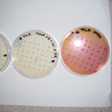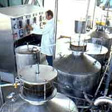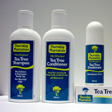 |
 |
|
 |
| |
I need to find out all the facts in order to create the best, most
profitable and most sustainable product.
|
|
|
 |
| |
Research
is needed at every point in the innovation cycle. Researchers
must assess many possibilities in order to identify the
most appropriate raw materials, the most efficient processes,
packaging and marketing strategies.
Research ranges from testing materials to asking consumers
about their buying habits. It relies on careful choice
of questions, for example:
- What's the cheapest, strongest material that can
be used for the purpose?
- How can I minimise the amount of material and energy
used to make or use the product?
- How effectively does my product do the job for
which it is designed?
- Is the product safe?
- How does my design allow for the product to be
recycled after its use?
- Who will buy this product, through which outlet
and for what price?
Thorough research is essential in the early stages of
innovation; this is often carried out in universities
or CSIRO and other government organisations. Continual
reassessment is important as the product develops; this
research is often carried out by industry.
Research that involves scientific testing needs to be
unbiased and carefully controlled. In any scientific experiment
or test, the test process is repeated and only one thing
(called a variable) is changed at a time. As well as the
people, plants or animals being tested in the experimental
group, there must be another group that is used as a control.
For that control group the variable is not changed, providing
a baseline against which experimental results are compared.
The individuals in the control group are as similar as
possible to those in the experimental group and are treated
the same way apart from the variable being tested.
For example, to test whether plants can survive without
water, take a large group of plants that are all the same
size, age and species. Divide the large group into two
to create one experimental and one control group. Grow
the plants in similar soil, give them the same amount
of sunlight but stop watering the experimental group.
Keep watering the control group. You can be pretty sure
that if the experimental group dies while the control
group remains healthy, the death is due to lack of water.
Tests of medical products often include double-blind trials
in which neither the patient nor the doctor knows whether
the patient is receiving medicine or a placebo. This allows
researchers to rule out the effects of "expectation
of success" by either the doctor or patient. A placebo
is a substance which has no medical properties but has
the same form, eg tablet or cream, as the active medicine.
A placebo has no physiological function but might assist
the patient psychologically. The medicine and placebo
are packaged in the same way but can be identified by
a number provided by the researchers. The doctor simply
records the number on the patient's file. Researchers
are the only ones who know which packages contain medicine
and can correlate results at the end of the trial.
International Centre for Scientific Research http://www.cirs.net/indexenglish.htm
CSIRO Australia http://www.csiro.au
|
|

|
| |
Australian tea tree oil — research for a healthy
future
Tea tree oil is a powerful antiseptic. The aboriginal
Bunjulung people of the NSW north coast have known about
it for thousands of years. They use it to take the sting
out of cuts and insect bites, and to successfully treat
bacterial, viral and fungal infections. Tea tree oil is
extracted from the leaves of a small native Australian
tree, Melaleuca alternifolia.
The oil contains high concentrations (up to 35%) of an
alcohol called terpinen-4-ol that's thought to be responsible
for most of the oil's antimicrobial activity. There are
more than 100 other chemicals in the oil.
In 1925, Arthur Penfold, a chemist and curator of Sydney's
Technological Museum (now the Powerhouse Museum), demonstrated
that tea tree oil was 13 times more powerful than phenol,
the standard antiseptic of the time. To do this, Penfold
gathered leaves from the bush, steamed them to release
the oil, and distilled the oil from the water. He then
tested the oil on the bacterium that causes typhoid.
For ten years Penfold provided oil to doctors and dentists
for clinical trials. Results were so convincing that tea
tree oil was sent to war with troops during World War
II. During the war, however, penicillin was introduced
to treat bacterial infections. The world fell in love
with new antibiotics like penicillin and forgot about
tea tree oil.
Interest in tea tree oil was rekindled in the 1980s. Growing
bacterial resistance to antibiotics is partly responsible
for this renewed interest. The tea tree industry has developed
dramatically from one relying on harvesting of naturally
occurring plants to one characterised by highly mechanised
intensive plantations. Australia leads the world in the
supply of high quality tea tree oil and associated products.
It currently produces about 400 tonnes of oil a year,
most of which is exported to North America and Europe.
Research has played a vital role in the development of
the industry and will be essential for its future.
|
|
 |
 |
| |
 |
| Close up of a tea tree leaf.
Courtesy Thursday Plantation. |
 |
| A section through a tea tree leaf showing a vein
beneath three oil glands. Technological Museum, Sydney. |
|
|
Research
for a growing industry
There are about 300 tea tree growers in Australia, all
hoping to compete successfully in a world market. The
industry body, the Australian Tea Tree Industry Association
(ATTIA), is working closely with the Rural Industries
Research & Development Corporation (RIRDC) to develop
a profitable and environmentally sustainable industry.
They hope to lead the world in marketing, value-adding,
product reliability and production. Research is needed
in this young industry in order to meet those goals.
Current research is under way in a number of areas. Two
examples of the importance of research to the tea tree
industry are:
- Testing the safety and effectiveness of tea tree
oil in laboratory and clinical trials designed to
meet the standards of Australian and international
regulatory authorities. This will lead to development
of new products in the areas of animal and plant health
and industrial hygiene. Safety tests will provide
information for formulation and labelling of products.
- Developing production systems that are both ecologically
sustainable and profitable. Maximising the yield of
oil will make best use of valuable resources, such
as land and water.
For more information about the tea tree industry see the http://www.teatree.org.au or http://www.rirdc.gov.au.
|
|
|
| |
 |
| Professor Thomas Riley. Courtesy University of
Western Australia Department of Microbiology. |
|
|
Testing
safety and effectiveness
Tea tree oil must meet national and international standards
for safety and efficacy before it can be accepted as a
valid antiseptic agent. Until recently, claims about its
power were based on anecdotes or on outdated scientific
methods.
For pharmaceutical and medical communities
to accept tea tree oil as a bona fide antimicrobial
agent, the results of investigations need to be published
in international journals acceptable to these groups.
Only when this occurs will tea tree oil move out of
the realms of quackery and alternative medicine.
Professor Thomas Riley, Department of Microbiology at
the University of Western Australia, 1998.
Professor Riley leads a team of scientists investigating
the antimicrobial activity and safety of tea tree oil.
So far they have demonstrated, using test tube (in vitro)
trials, that the oil is active against a wide range of
bacteria, viruses and fungi. For more information about
their research see http://www.meddent.uwa.edu.au/teatree.
|
|
|
| |
 |
| Testing bacteria growth in tea tree oil. Courtesy
University of Western Australia Department of Microbiology. |
|
|
Laboratory trials
Before registering a health-care antiseptic, the Food
and Drug Administration of the USA requires a list of
all the organisms that are killed by the antiseptic. Riley's
team designed experiments to test the susceptibility of
organisms to tea tree oil. They aimed to identify the
minimum concentrations of oil that would inhibit growth
or kill particular micro-organisms. They tested many micro-organisms
including:
- Escherichia coli, which causes gastroenteritis
- Pseudomonas aeruginosa, a penicillin-resistant
bacterium that infects wounds, burns, and the urinary
and respiratory tracts
- Methicillin-resistant strains of Staphylococcus
aureus (Golden staph), a major cause of hospital-acquired
infections
- Streptococcus and Staphylococcus species, which
cause skin infections including impetigo
- Propionibacterium acnes, which plays a role in
acne
- Candida albicans, a fungus that causes thrush infections.
The team grew the organisms in several warm broths containing
varying concentrations of tea tree oil for 24 hours. They
found that the growth of most of the organisms was inhibited
at an oil concentration of 0.25%v/v (volume/volume, ie
0.25ml of tea tree oil added to 99.75ml of broth). Most
of the organisms died at 0.50% while an oil concentration
of 3.0% was needed to kill the penicillin-resistant bacteria
Pseudomonas aeruginosa. All of these findings have been
published in international journals.
Clinical
trials
Controlled, double-blind clinical trials are under way
to test the effectiveness of the oil in treating a number
of infections, including thrush, impetigo, methicillin-resistant
golden staph, and cold sores caused by the Herpes labialis
virus. These projects are funded by RIRDC and Australian
Bodycare Pty Ltd, and involve hospital patients in Western
Australia and NSW.
|
|
|
| |
 |
| Patch tests containing tea tree oil are used
to determine skin sensitivity. Courtesy University of
Western Australia Department of Microbiology. |
|
|
Skin sensitivity trials
Skin sensitivity trials have been carried out to determine
the prevalence and characteristics of allergy or sensitivity
to tea tree oil. This research is essential for the formulation,
packaging and labelling of products. The research involved
testing more than 200 healthy volunteers for allergy to
tea tree oil using two different tests, the prick test
and the patch test. Ten different tea tree oils were tested.
The prick test involved applying oil to the skin, then
breaking the skin with a needle. Other common allergens,
including dust mite and grass, were tested at the same
time (on different areas of skin!) to determine whether
the volunteers were more or less allergic than average.
Any reactions were noted immediately.
The patch test involved sticking squares of material soaked
in different concentrations of oil onto each patient's
skin. Patches were left in place for some time and then
checked. This test detected delayed irritant reactions
and allergic contact dermatitis. Any volunteer who showed
a reaction to tea tree oil was tested again with 100%
oil, 10% oil and then the major oil components.
The prevalence of allergy in the whole group was 2.9%
(up to a possible 4.8% if mild reactions are included).
Incidence of reactions to the other common allergens indicated
that the test subjects were somewhat 'more allergic' than
the general public.
Irritant reactions were particularly concentration dependent,
which means that many of these reactions should be avoidable
if a lower concentration of oil is used in formulations.
Very few reactions occurred in response to tea tree oil
components. Subsequent tests demonstrated that allergic
reactions are generally caused by oxidation products of
tea-tree oil, rather than the fresh oil itself. These
findings provided valuable information regarding the formulation
and packaging of the oil products. That is, low concentrations
should be used and the oil should be stored in brown glass
bottles, away from heat and light in order to prevent
oxidation.
|
|
|
| |
 |
|
A tea tree plantation. Courtesy Thursday Plantation. |
 |
| A tea tree oil production system. Courtesy Thursday
Plantation. |
|
|
Developing production systems
Research in this area aims to boost the amount of oil
produced by each tree in order to maximise the yield from
available resources, including land and water. The main
focus is on the selective breeding of high-yielding trees
and on the appropriate management of trees in different
growing areas and climates.
Selective breeding of trees
Growing the highest yielding trees in a plantation makes
sense. In the past, people grew seeds collected from a
limited number of bush trees. CSIRO and NSW Agriculture
have increased the quality of seed available for growers
as a result of eight years' research at the Wollongbar
Agricultural Institute, near Lismore, NSW. They have created
a 'seed orchard' which produces high quality seed.
First, they assessed the variability in oil yield and
quality from individual trees in their field trials. They
progressively culled inferior trees and developed controlled
pollination techniques to produce desirable hybrids. Genetic
technologies were also employed in the research. They
identified the genes responsible for oil yield and quality,
and breeding lines can now be DNA fingerprinted. The first
batch of improved seed was distributed in 1997, and the
second-generation seed orchard was established from seedlings
in 2001.
A 30% increase in oil yield is predicted through use of
this improved seed, and further culling of the orchards
over time is expected to give improvements of 60%. The
results of this ongoing research will help to maintain
the financial viability of the industry.
Managing plantations
A research project in the Atherton Tableland of North
Queensland has implications for the way trees are managed
for maximum oil production. In the 1990s, tobacco quotas
fell and farmers on the Tableland replaced their tobacco
crops with tea trees. Previously the tea tree industry
had been located almost exclusively in northern NSW and
was very new to Queensland.
In these areas tea trees are being grown
in different climates and on different soil types. Little
was known about the levels of production or how to manage
the trees. Growers had used information from NSW to
help establish plantations; however there was a real
need for research work to adapt and alter this information
and determine the factors which affect oil concentrations
and yields in these areas.
Dr James Drinnan, RIRDC Communications.
The research involved collaboration and cooperation between
the NSW Department of Agriculture, the Australian Tea
Tree Industry Association, and the Rural Industries Research
and Development Corporation.
Because all tea tree farms on the Atherton tablelands
are irrigated, much of the research focussed on the best
way to tailor water use to the needs of the crop. Irrigation
is a major expense, so it needs to be as cost-effective
as possible. A water monitoring system (Enviroscan) was
installed on a farm that had soil and water use typical
of the area. Sensors were installed in the soil at 100-800
mm depths to determine the water requirements of seedlings,
mature trees, and trees regrowing after harvest.
Researchers also measured changes in oil yields from the
trees throughout the year and in response to irrigation.
Research in New South Wales had already shown that the
amount of oil obtained one day after irrigation was less
than half that obtained from the same crop four days after
irrigation. This sort of information is crucial for the
maximisation of yield from a plantation.
Other research has shown that tea trees have high requirements
for iron, zinc and copper. And the optimum harvesting
time is either December or just after the wet season in
April.
Thus research has demonstrated that the major factors
influencing yield are genetics, irrigation and nutrition.
It is essential to start with seeds from good genetic
stock, to regularly irrigate and fertilise the crop, and
to harvest at the appropriate time. This information has
changed the farming practices and profits of growers in
the Atherton Tableland and is potentially valuable for
growers wishing to establish plantations in other parts
of Australia.
The Rural Industry Research and Development Corporation
funds many of the research projects currently under way
in the tea tree industry. Reports on those projects can
be found at http://www.rirdc.gov.au/reports.
|
|
|
| |
 |
| Tea tree oil products sold by Thursday Plantation.
Courtesy Thursday Plantation. |
|
|
The
impacts
Through the research efforts of academics and the Australian
tea tree industry, the properties of tea tree oil are
becoming recognised and accepted within mainstream medicine.
Production methods have been improved in the last 20 years
such that the volume of tea tree oil produced in Australia
has increased by almost 20 times. More than 80% of this
oil is exported, usually as bulk oil.
|
|
|
| |
Links and references
Australian Tea Tree Industry Association http://www.teatree.org.au
Rural Industries Research & Development Corporation
http://www.rirdc.gov.au
Wollongbar Agricultural Institute http://www.agric.nsw.gov.au/general/centres/wollongbar
CSIRO http://www.csiro.au
University
of Western Australia Tea Tree Research http://www.meddent.uwa.edu.au/teatree
Technical paper by UWA researchers http://www.teatree.co.uk/research.htm
Tea Tree Oil UK http://www.teatree.co.uk
Thursday Plantation http://www.thursdayplantation.com.au
Key
organisations
Australian Tea Tree Industry Association
Rural Industries Research & Development Corporation
University of Western Australia Tea Tree Oil Research
Group
Thursday Plantation
Jobs
and skills
Scientists (biologist, chemist, immunologist, horticulturalist)
Plantation manager
Farmer
Nurse
Discussion
questions
K-6
1. What did the Aboriginal Bunjulung people of the NSW
north coast use tea tree oil for?
2. Using a tape recorder, interview an expert (botanist,
horticulturist, gardener) about how to grow a tea tree.
3. Research an Indigenous Dreaming story about tea tree.
4. Using a digital camera record images of tea trees and
tea tree products. Look for trees in gardens, (eg. botanical
gardens), in plant nurseries or in your local area. Make
a collage, drawing or diagram which shows the process
of making tea tree oil.
7-10
1. Research how Indigenous peoples used tea tree for antiseptic
purposes. Draw a timeline to show how different people
in different times used tea tree oil to treat infection.
2. As a market researcher, what kinds of questions would
you ask consumers about a product like tea tree oil? Design
a questionnaire to ascertain buying habits.
3. List the main micro-organisms used in laboratory trials
to test tea tree oil’s antiseptic qualities. Discuss
the findings of these trials.
4. What is ecological sustainability? How important is
it to the tea tree industry?
11-12
1. What kinds of questions might a scientific researcher
ask when investigating the best way to create a product?
2. What is usually required before a pharmaceutical or
medical preparation is accepted as safe and effective?
3. Why are skin sensitivity trials so important?
4. Perform a first-hand investigation to measure the pH
value of a range of tea tree products.
|
|
|
 |
  |
|
|
|



















